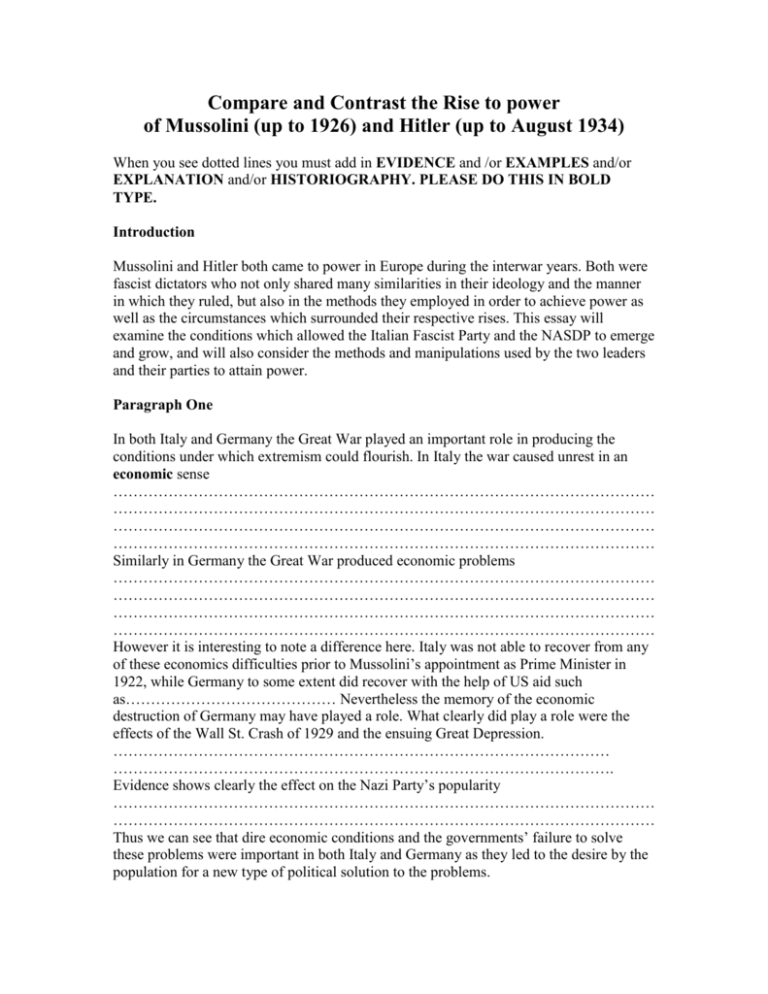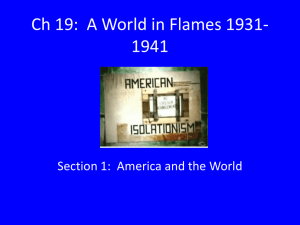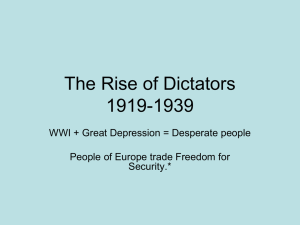Compare and Contrast the Rise to power
advertisement

Compare and Contrast the Rise to power of Mussolini (up to 1926) and Hitler (up to August 1934) When you see dotted lines you must add in EVIDENCE and /or EXAMPLES and/or EXPLANATION and/or HISTORIOGRAPHY. PLEASE DO THIS IN BOLD TYPE. Introduction Mussolini and Hitler both came to power in Europe during the interwar years. Both were fascist dictators who not only shared many similarities in their ideology and the manner in which they ruled, but also in the methods they employed in order to achieve power as well as the circumstances which surrounded their respective rises. This essay will examine the conditions which allowed the Italian Fascist Party and the NASDP to emerge and grow, and will also consider the methods and manipulations used by the two leaders and their parties to attain power. Paragraph One In both Italy and Germany the Great War played an important role in producing the conditions under which extremism could flourish. In Italy the war caused unrest in an economic sense ……………………………………………………………………………………………… ……………………………………………………………………………………………… ……………………………………………………………………………………………… ……………………………………………………………………………………………… Similarly in Germany the Great War produced economic problems ……………………………………………………………………………………………… ……………………………………………………………………………………………… ……………………………………………………………………………………………… ……………………………………………………………………………………………… However it is interesting to note a difference here. Italy was not able to recover from any of these economics difficulties prior to Mussolini’s appointment as Prime Minister in 1922, while Germany to some extent did recover with the help of US aid such as…………………………………… Nevertheless the memory of the economic destruction of Germany may have played a role. What clearly did play a role were the effects of the Wall St. Crash of 1929 and the ensuing Great Depression. ……………………………………………………………………………………… ………………………………………………………………………………………. Evidence shows clearly the effect on the Nazi Party’s popularity ……………………………………………………………………………………………… ……………………………………………………………………………………………… Thus we can see that dire economic conditions and the governments’ failure to solve these problems were important in both Italy and Germany as they led to the desire by the population for a new type of political solution to the problems. Paragraph Two In both countries the governments’ inability to solve the economic problems was partially due to the political weaknesses with the existing systems. Italy, since unification in 1871 had suffered from successively weak governments ……………………………………………………………………………………………… ……………………………………………………………………………………………… Since World War One ……………………………………………………………………………………………… ……………………………………………………………………………………………… ……………………………………………………………………………………………… In Germany the Weimar Republic had suffered particularly badly since 1930 ……………………………………………………………………………………………… ……………………………………………………………………………………………… ……………………………………………………………………………………………… ……………………………………………………………………………………………… ……………………………………………………………………………………………… ……………………………………………………………………………………………… But also had been beset by problems since it’s creation in 1919 ……………………………………………………………………………………………… ……………………………………………………………………………………………… ……………………………………………………………………………………………… Had either country had a more effective and stronger political base, the rise of the dictators may have stood more chance of being blocked. But also, many voters were anxious to replace their seemingly ineffective and indecisive governments. Paragraph Three Both countries were also beset with problems in foreign relations, many of which were as a result of World War One. Italy, although one of the victorious allies, had not gained all that she expected from the Treaty of London of 1915 ……………………………………………………………………………………………… ………………………………………………….. despite Prime Minister Orlando’s presence at Versailles. This led to the occupation of ……………………………………………………………………, an embarrassing incident for the Italian government which showed the extreme dissatisfaction of some elements in Italian society, particularly the extreme nationalists. A combination of this and the economic effects of the war led to it being referred to as the “mutilated victory”. The German situation was probably far worse. The Treaty of Versailles not only hurt Germany economically but it also diminished her status as a world power by ……………………………………………………………………………………………… ……………………………………………………………………………………………… ……………………………………………………………………………………………… ……………………………………………………………………………………………… The Weimar government who signed the treaty was of course blamed for the ‘stab in the back’. Germany had then suffered a period of isolation and exclusion up to……………………………..which added to the humiliation. The feelings of resentment and blame were to resurface in the atmosphere of the early 1930’s. Again, in both countries we see a failed foreign policy which resulted in national humiliation and a desire for revenge. In both cases the governments were blamed for the failures. Paragraph Four Both the Italian fascists and the NSDAP claimed to be able to solve the problems discussed above. In addition they offered a new ideology which appealed to large numbers of people in desperate conditions. Fascist ideology offered ……………………………………………………………………………………………… ……………………………………………………………………………………………… ……………………………………………………………………………………………… In Italy these appealed to ……………………………………………………………………………………………… ……………………………………………………………………………………………… ……………………………………………………………………………………………… In Germany this appealed to ……………………………………………………………………………………………… ……………………………………………………………………………………………… ……………………………………………………………………………………………… In both countries the anti-communist nature of fascism was very important as in both countries communism seemed a real threat ……………………………………………………………………………………………… ……………………………………………………………………………………………… ……………………………………………………………………………………………… ……………………………………………………………………………………………… Thus we can see that in the circumstance of the time, a new ideology which offered solutions to long term problems proved popular in both countries. Paragraph Five Both Hitler’s and Mussolini’s personal role should not be underestimated. Both were charismatic characters who personally were popular with audiences ……………………………………………………………………………………………… ……………………………………………………………………………………………… ……………………………………………………………………………………………… As well as the projection of a cult figure other propaganda ploys played an important role ……………………………………………………………………………………………… ……………………………………………………………………………………………… ……………………………………………………………………………………………… ……………………………………………………………………………………………… In the case of both men, personality and how it was projected played a crucial role in gaining the support of the public. Paragraph Six The use of paramilitary groups is a common theme in the rise of many single party states and Hitler and Mussolini are leaders who illustrate this very clearly. ……………………………………………………………………………………………… ……………………………………………………………………………………………… …………………………………………………………………………………… These groups were used against opponents, particularly communists. Examples of this are ……………………………………………………………………………………………… …………………………………………………………………………………………….. The paramilitary organizations seemed to deal with a threat that the government could not and at the same time were a threat of force themselves. It is interesting that both Mussolini and Hitler did have to distance themselves from the activities of their respective paramilitaries in order to maintain a respectable image with the public.. Paragraph Seven Perhaps the greatest difference between the achievements of power of these two dictators lays in the manner in which they finally achieved power. Mussolini was offered the job of Prime minister by King Victor Emmanuel after the March on Rome in 1922 ……………………………………………………………………………………………… ……………………………………………………………………………………………… ……………………………………………………………………………………………… …………………………………………………………………………………………… Hitler tried a similar coup in1923 but failed ……………………………………………………………………………………………… ……………………………………………………………………………………………… ……………………………………………………………………………………………… He vowed to gain power through parliamentary means and eventually Hitler too, was offered the equivalent position of Chancellor by his Head of State, President Hindenburg. However the situation was a very different one. ……………………………………………………………………………………………… ……………………………………………………………………………………………… ……………………………………………………………………………………………… ……………………………………………………………………………………………… ……………………………………………………………………………………………… ……………………………………………………………………………………………… Thus Mussolini and Hitler both gained power in more or less legal ways but with varying degrees of manipulation and/or threats of force. Hitler took advantage of a ‘court intrigue’ whilst Mussolini typically chose the dramatic, legend-making route. Paragraph Eight This should be on the consolidation of power up to 1926 (for Mussolini) and August 1934 (for Hitler). Remember to compare and to contrast. Conclusion Therefore it is clear that the circumstances surrounding the growth in popularity of the Italian fascists and the German NASDP are similar. Both were suffering the effects of the Great War in terms of their weak economies, unstable governments and failed foreign policies. The two emergent political parties also have their similarities; ideology, a charismatic leader, paramilitary groups. The main differences are the actual method of achieving power and the fact that Mussolini gained power much earlier in the period than Hitler. In the early 1920s Mussolini seemed far more acceptable to the Italian political elite than Hitler did the German equivalent. You will be graded using the Knowledge and Context and Processes criteria only (see below) IBHL Grading Rubric IB Grade and Score ISM Grade and % Demands of the Question Knowledge Context and Processes Historiography Organization 7 Answers are clearly focused responses, showing a high degree of awareness of the demands of the question. Where appropriate, answers may challenge the question successfully. . In-depth and accurate historical knowledge is applied consistently and convincingly to support critical commentary. In addition, answers may reveal a high level of conceptual ability. Events are placed in their historical context. There is a clear understanding of historical processes and (where appropriate) comparison and contrast. There may be evaluation of different approaches to, and interpretations of, historical issues and events. This evaluation is integrated effectively into the answer to support and supplement the argument. In addition, an awareness of the reasons for circumstances that produced differing and often conflicting historical interpretations is present. Answers are well structured and clearly expressed, using evidence to support relevant, balanced and well-focused arguments. Synthesis is highly developed, with knowledge and critical commentary fully and effectively integrated Answers are clearly focused responses, showing a high degree of awareness of the demands of the question. Where appropriate, answers may challenge the question successfully. In-depth and accurate historical knowledge is applied consistently and convincingly to support critical commentary. Events are placed in their historical context. There is a clear understanding of historical processes and (where appropriate) comparison and contrast. There may be evaluation of different approaches to, and interpretations of, historical issues and events. This evaluation is integrated effectively into the answer to support and supplement the argument. Answers are well structured and clearly expressed, using evidence to support relevant, balanced and focused arguments. Synthesis is well developed, with knowledge and critical commentary fully and effectively integrated. Answers are clearly focused responses to the demands of the question. Relevant in-depth historical knowledge is applied as evidence. Critical commentary indicates some in-depth understanding but is not consistent throughout. Events are placed in their historical context. There is a sound understanding of historical processes and (where appropriate) comparison and contrast. There may be awareness and some evaluation of different approaches to, and interpretations of, historical issues and events. These are used to supplement, in a relevant manner, the arguments presented. Answers are well structured using evidence to support relevant historical arguments. Synthesis is present but not always effectively or consistently integrated 18 19 20 94 97 100 A A A In addition to the objectives opposite answers in this level must demonstrate at least one of the additional qualities outlined in italics. 6 15 16 17 87 90 93 B+ A- A- 5 12 13 14 80 83 86 B- B B 4 9 10 11 73 76 79 C C C+ 3 7 8 9 63 66 69 D D D+ 2 5 6 60 62 D- D1 3 4 Answers indicate that the demands of the question are understood and addressed, though not all implications are considered. Relevant, largely accurate in-depth historical knowledge is present and applied as evidence. Critical commentary indicates some understanding. Events are generally placed in their historical context. There is an understanding of historical processes and (where appropriate) comparison and contrast. There may be some awareness of different approaches to, and interpretations of, historical issues and events. However, responses that mainly summarize the views of historians and use these as a substitute for, rather than a supplement to, the deployment of relevant historical knowledge cannot reach the top of this band. There is a clear attempt to structure answers chronologically or thematically. Synthesis is present but underdeveloped Answers indicate that the demands of the question are generally understood. . Relevant in-depth historical knowledge is present but is unevenly applied throughout. Answers are presented in a narrative or descriptive manner. Alternatively, there is a limited argument that requires further substantiation. Some attempt at analysis may be present but limited There has been some attempt to place events in their historical context and to show an understanding of historical processes and (where appropriate) comparison and contrast. There is no awareness of different approaches to, and interpretations of, historical issues and events. There is evidence of an attempt to follow a structured approach, either chronological or thematic. Answers indicate some understanding of the question. There is some relevant, accurate historical knowledge but detail is insufficient. Understanding of historical processes and (where appropriate) comparison and contrast may be present but underdeveloped. There is no awareness of different approaches to, and interpretations of, historical issues and events. While there may be a recognizable essay structure, the question is only partially addressed. Answers reveal little understanding of the While historical details are present, they are largely There is little or no understanding of historical There is no awareness of different approaches to, While there may be a recognizable essay 55 59 F F question. inaccurate and/or of marginal relevance to the task. context or historical processes. and interpretations of, historical issues and events. structure, answers consist of little more than poorly substantiated assertions






